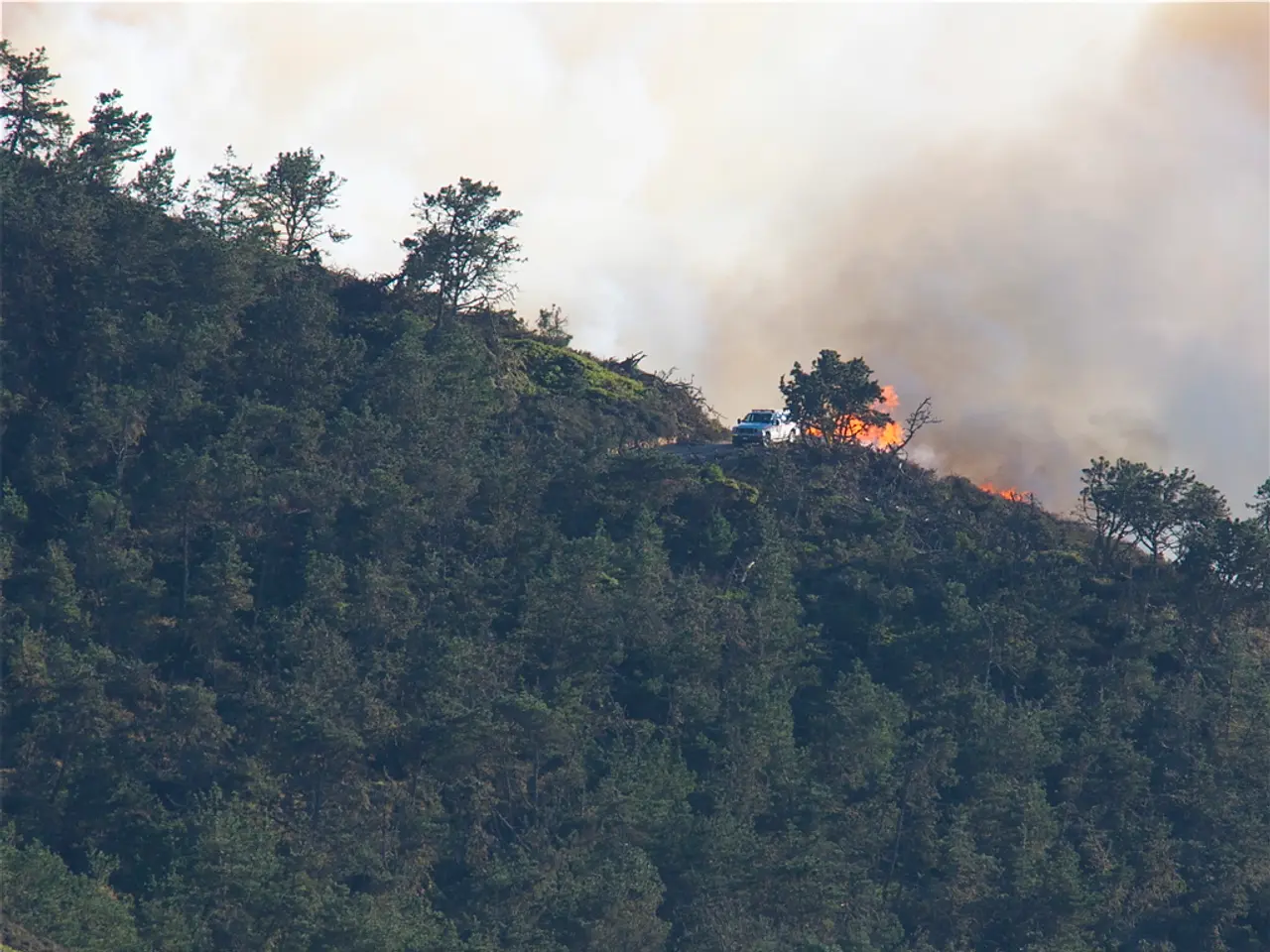Smoky haze from wildfires lingers over northern Ontario, leading to air quality warnings and health advisories
Northeastern Ontario regions, including Sudbury, North Bay, Sault Ste. Marie, and Timmins, are currently experiencing poor air quality due to widespread wildfire smoke. This smoke contains fine particulate matter (PM2.5) and black carbon (soot), which can aggravate respiratory and cardiovascular conditions and pose serious health risks, particularly to vulnerable groups such as children, the elderly, and those with pre-existing conditions [1][5].
Air quality alerts and health warnings have been issued in northern Ontario, indicating elevated Air Quality Health Index (AQHI) values reaching levels that signify very high health risk (level 10 or above). These warnings recommend limiting outdoor activities to reduce exposure to smoke-related pollutants [1][5].
Health risks include increased rates of respiratory distress and exacerbations of chronic lung diseases due to fine particulate pollution. Ground-level ozone formation, which can be enhanced by wildfire smoke, also contributes to smog and respiratory irritation, especially in the afternoon to early evening when ozone levels tend to peak [3]. Individuals experiencing symptoms like coughing, shortness of breath, or chest pain are advised to seek medical advice [3].
Air quality models such as NASA’s GEOS and regional smoke forecasts like BlueSky Canada predict that smoke will continue to affect large swaths of northern Ontario for the next several days, although local concentration and timing of smoke vary with weather and fire behavior [1][4][5].
Residents are advised to limit outdoor exposure, reschedule strenuous activities, and keep windows and doors closed indoors. Using air filters or portable air cleaners indoors can help mitigate risks [1][3][5]. For those who must be outside, wearing a well-fitted N95 respirator is recommended to reduce smoke exposure [1][3][5].
Authorities encourage citizens to stay informed as conditions evolve. Real-time air quality measurements are available at canada.ca/wildfire-smoke, and additional resources, including air quality data, are available at airhealth.ca. Following local guidance and monitoring updates through Environment Canada's alerts is emphasized [1].
The weather agency advises checking on neighbors who may be more susceptible to poor air quality. Symptoms such as eye irritation, coughing, or wheezing should prompt individuals to seek medical attention if severe [1]. Residents are reminded to take extra precautions for vulnerable populations, including seniors, pregnant individuals, young children, and those with pre-existing health conditions [1].
As of Sunday morning, the alert for Timmins and surrounding communities was dropped. The smoke is expected to ease over portions of northeastern Ontario today [2]. For the latest updates and information, residents are encouraged to follow Environment Canada's alerts and local news sources.
- Poor air quality due to wildfire smoke could exacerbate chronic kidney disease and type-2 diabetes, as well as other chronic diseases.
- The news about the ongoing wildfire smoke in northern Ontario highlights the impact of climate change on human health and the environment.
- Environmental science scholars emphasize the urgent need for research on the health effects of wildfire smoke and climate change.
- Air quality during wildfire events can affect the health of the eyes, causing irritation or discomfort.
- The respiratory health of individuals with COPD and asthma can be negatively impacted by prolonged exposure to wildfire smoke.
- Hearing loss and tinnitus have been linked to exposure to fine particulate matter in wildfire smoke.
- Climate-change-induced wildfires can lead to digestive health issues due to the ingestion of smoke particles.
- Men's health can be affected by the increased risk of respiratory conditions as a result of wildfire smoke.
- Proper skin care is essential as wildfire smoke can cause skin conditions such as dermatitis or rashes.
- The Си that can result from wildfire smoke may have an impact on the sleeping patterns of affected individuals.
- Psoriasis, an autoimmune disorder, may be exacerbated by prolonged exposure to pollutants from wildfire smoke.
- Amongst the risks posed by wildfire smoke, the development of neurological disorders like Alzheimer's disease is a cause for concern.
- Therapies and treatments for various medical conditions may need to adapt to address the health risks presented by wildfire smoke exposure.
- The smoke from ongoing wildfires can have a significant impact on breast-cancer risk factors, particularly in areas with high concentrations of fine particulate matter.
- Implementing workplace-wellness programs can help protect employees from the negative health effects of wildfire smoke, enhancing overall fitness and exercise routines.
- Parents should take steps to mitigate the health risks posed by wildfire smoke for their children, ensuring adequate nutrition and proper hydration.
- Self-care during wildfire smoke events also includes maintaining mental health, as the anxiety and stress triggered by such events can contribute to poor overall health.
- CBD usage may have a role in mitigating the respiratory symptoms triggered by wildfire smoke exposure.
- Skin care products infused with CBD can offer protection against the irritating effects of wildfire smoke.
- Rheumatoid arthritis patients may experience worsening symptoms due to increased inflammation induced by wildfire smoke.
- Minimizing the risk of migraines during wildfire smoke events involves adhering to recommended air quality guidelines, staying hydrated, and practicing good stress management techniques.




